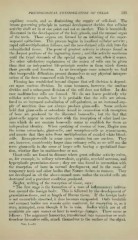Page 519 - My FlipBook
P. 519
PHYSIOLOGICAL CONSIDERATION OF CELLS. 529
capillary vessels, and so diminishing the supply of cell-food. The
innate governing principle in normal development decides that cellular
activity shall set in at one point and not at another. This is beautifully
illustrated in the development of the hair, glands, and the enamel organ
of the teeth. These organs are formed by an infolding of the super-
imposed epithelium. This process begins in localized cellular activity
;
rapid cell-multiplication follows, and the new-formed cells sink into the
subepithelial tissue. The point of greatest activity is always found in
the deepest portions of the ingrowing tissue ; and this activity continues
until the typal demands of the special organ are met, Avhen it ceases.
No other satisfactory explanation of the action of cells can be given
than that an independent life-principle resides in them which directs
their growth and function. As we investigate more minutely we find
that insuperable difficulties present themselves to any physical interpre-
tation of the facts connected with living cells.
Fleming has established beyond dispute that cell division is depend-
ent upon nucleus division. In some instances, however, the nucleus
divides and a subsequent division of the cell does not follow. In this
case multinuclear cells are formed. We do not know positively why
cellular activity results, but it is probable that the cells are stimu-
lated to an increased assimilation of cell-pabulum, as an increased sup-
ply of nutrition does not always produce giant-cells. Some authors
hold that giant-cells or osteoclasts found in connection with resorption
of bone are produced by the liberated bone-cells ; but the fact that
giant-cells appear in connection with the resorption of other hard tis-
sues which do not contain bone-cells seems to establish for them an
independent identity. When speaking of erosion of bone, Ziegler uses
the terms osteoclasts, giant-cells, and resorption-cells as synonymous,
and asserts that they arise from multiplication of exuded white blood-
cells. Resorptive-cells in some cases contain but one nucleus. They
are, however, considerably larger than ordinary cells, so we will use the
term giant-cells in the sense of larger cells having a specialized func-
tion, whether they be multinuclear or not.
Giant-cells are found in diseases where great cellular activity exists,
as, for example, in miliary tuberculosis, syphilis, myeloid sarcoma, and
hyperplastic granulation-tissue ; they are also found in connection with
the resorption of bone in normal development, and in the roots of
temporary teeth and other bodies that Nature desires to remove. They
are developed in all the above-named cases unless the exuded cells are
destroyed and a purulent condition produced.
Ziegler, writing of the resorption of tissue, says :
" Tiie first stage is the formation of a zone of inflammatory infiltra-
tion around the foreign body. This is followed by the development of
granulation-tissue, and at length of fibrous tissue. If the foreign body
is not meanwhile absorbed, it thus becomes encapsuled. Only insoluble
and compact bodies can remain quite unaltered, for resorption is, as it
were, attempted, even though it be in vain. Bodies which are at all
assailable are sure sooner or later to undergo changes. These ensue as
follows : The migratory leucocytes, transformed into uninuclear or mul-
tinuclear formative cells, attach themselves to the surface of the object.
Voi,. I.—34


